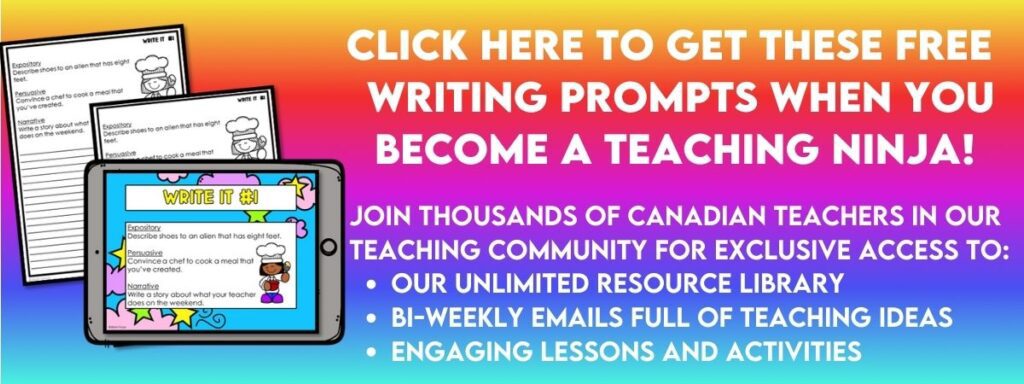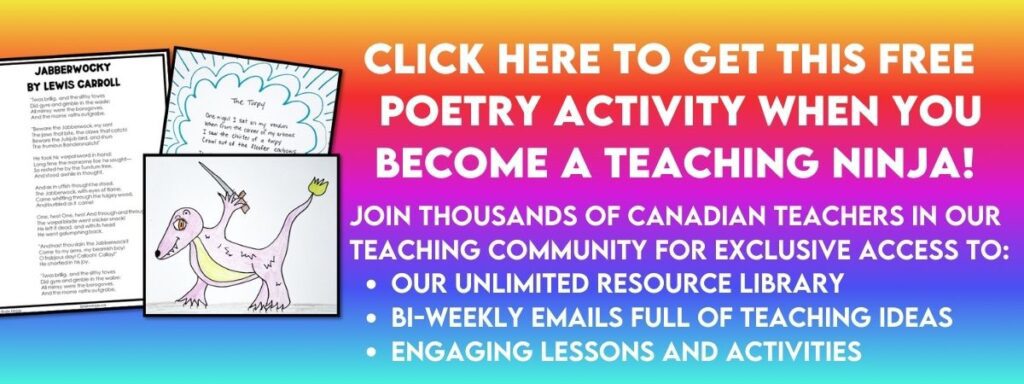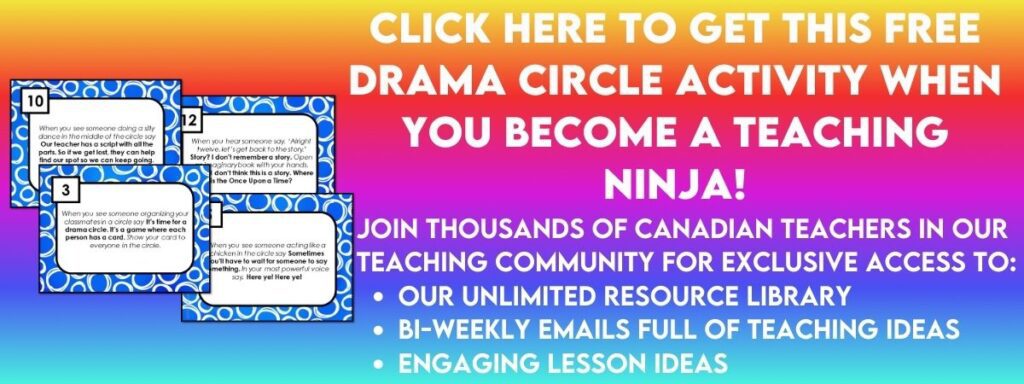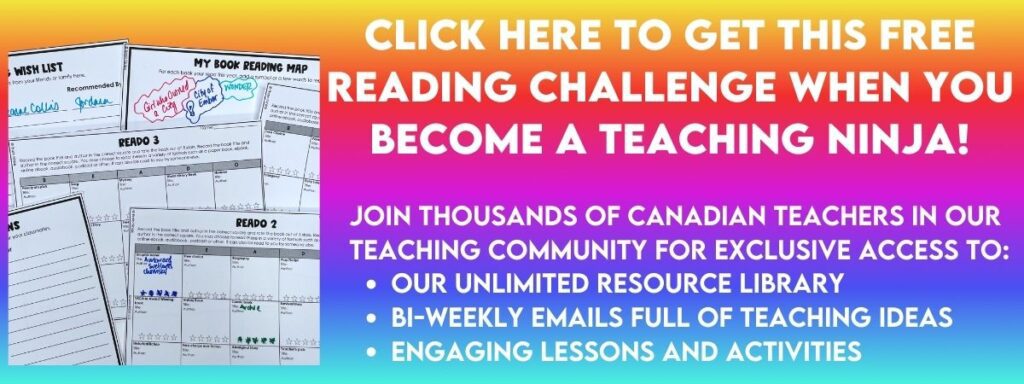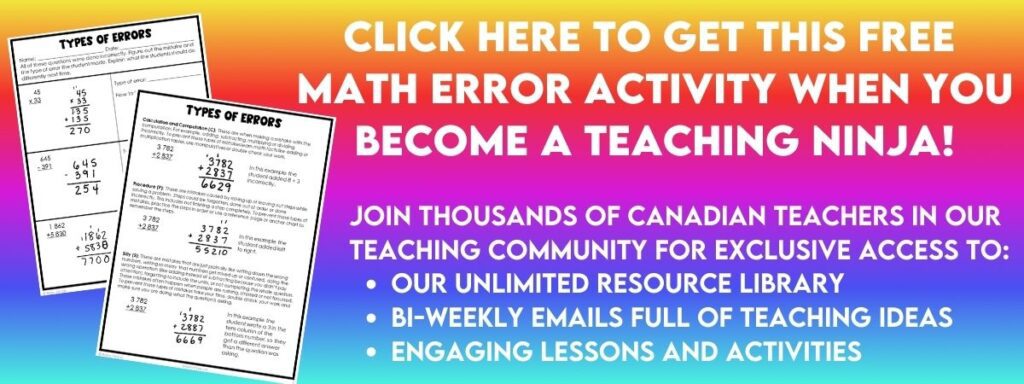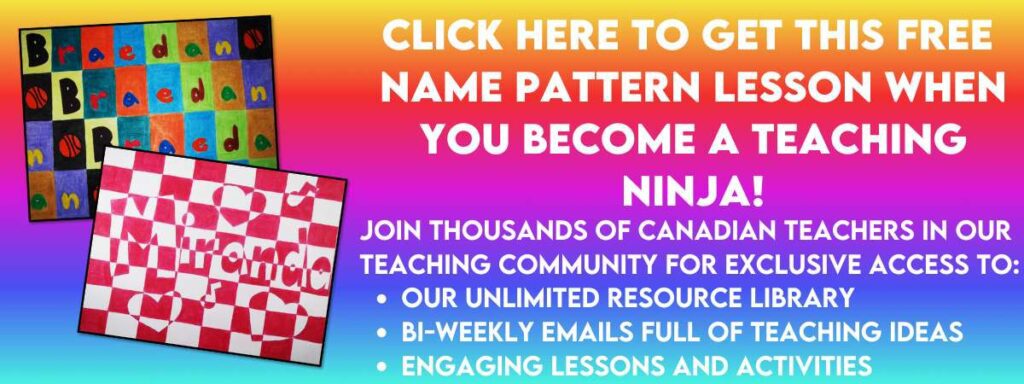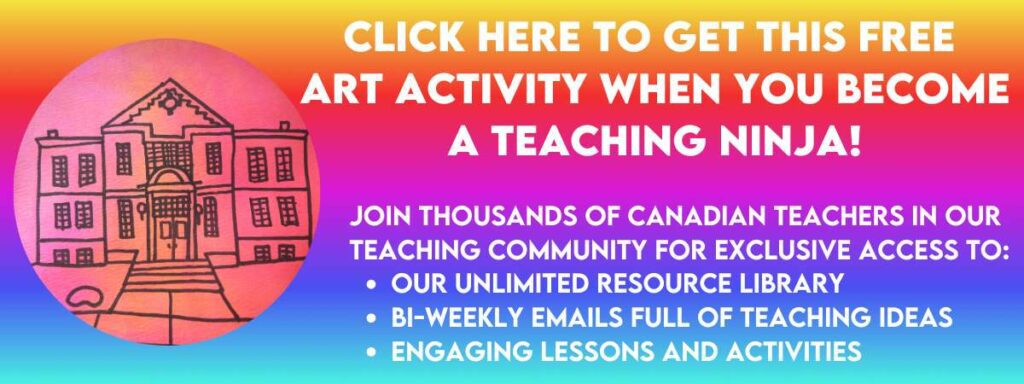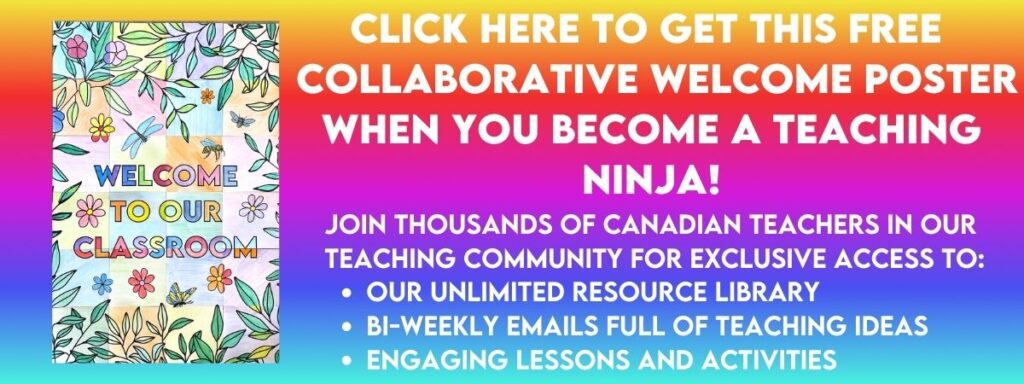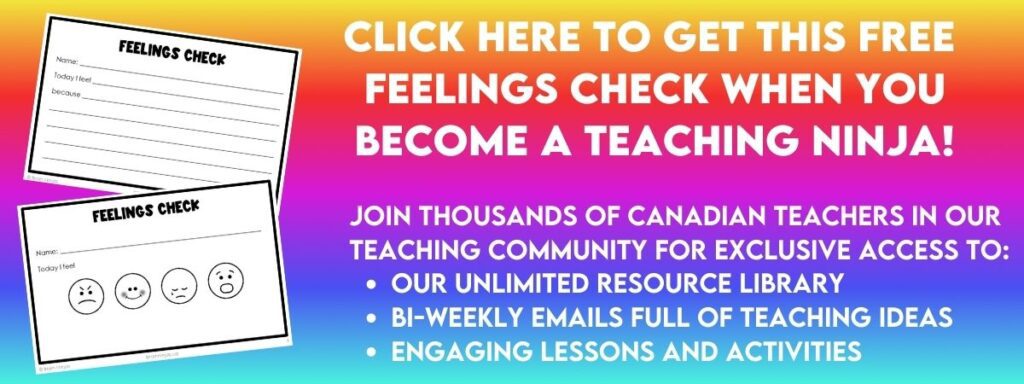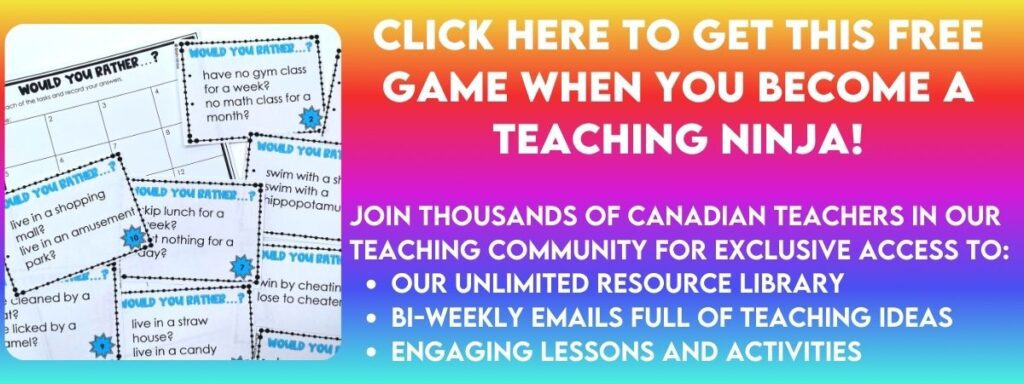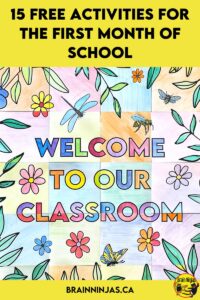
The first month of school is filled with so many new adventures. There is so much to do regarding setting up classroom routines. We don’t start teaching content until a few weeks into the school year. Up until that time, we see what our students can do. We generally assess reading and writing, and review math. This is a great way to get to know your students so you can plan your lessons for their needs. Here are nine free activities we use for the first month of school.
Some of these free activities are found in our Teachers Pay Teachers Store and Brain Ninjas Shop. That means you’ll need an account to download them (still free). Some of these resources are found in our Resource Library. Access to the library is provided to members of our email list. If you’re already a ninja, just pop on over and download what you need.
If you’re not a ninja yet, use the form to sign up for the free lesson. You only need to sign up once. Once you’ve confirmed your email, you’ll receive an email that contains the password, and you’ll be able to download the rest (without signing up several times).
Writing
Use Writing Prompts
Do you have a lot of students who get stuck thinking of what to write about? We reduced the problem by creating more writing prompts than anyone could ever use in an entire year. Our prompts always have three suggestions for each day. They come in a paper version and a Google Slides version. This sample comes with three days of prompts (which is nine prompts total). It also contains links to find a few more free sets. Check out the writing prompts. If you’re looking to learn more about how to use writing prompts throughout the school year, try reading Challenge Your Students with Writing Activities Every Day or How to Include Different Types of Writing in Your Classroom.
Back to School Writing and Bulletin Board
This simple activity asks students to pick one event and write out the long version. Then they summarize the whole thing in one sentence. It comes with a cute pair of shorts to write on. This makes a great bulletin board, “The Long and the Short of It,” for back-to-school and meet-the-teacher.
You can find this free activity in our TpT Store or Brain Ninjas Shop.
Poetry Activity
This activity includes a little bit of reading and a bit of writing. The writing part is a lot of fun. Students read Lewis Caroll’s Jabberwocky and learn a few aspects of poetry. The lesson part can be as simple or as in-depth as you need. Then, students will create their own version of a nonsense poem. This is a low-risk activity for all your students because spelling doesn’t matter, and students can use any sounds they want, making it a good activity for your English Language Learners. Check out this poetry activity here.
Reading
How to Do A Drama Circle
Our students love drama circles. They are cards that students read and possibly perform an action. This triggers another card performed by another student.
Drama circles are a great way to help students with oral reading fluency, reading with expression and elements of drama. They reinforce listening skills, performance skills, and they are just plain fun.
We have several drama circles in our stores, but this drama circle is one that teaches students how to do drama circles.
If you’re looking for more ideas about how to use drama circles read Ways to teach Drama in the Classroom.
Back to School Logic Puzzle
Logic puzzles teach problem solving, reading for important information and critical thinking. Our students love logic puzzles and have suggested many of the puzzle topics over the years. Our puzzles are both paper and have a Google Slides version (but it needs a mouse or very skilled trackpad fingers).
You can find this back to school themed puzzle in our Teachers Pay Teachers Store or Brain Ninjas Shop.
Reading Challenge
We don’t think students should have to track the pages or number of minutes read. They should get to read for the love of reading. Instead, we try to broaden their horizons by reading a variety of different formats and getting recommendations from different people. We’ve used this reading challenge (it has three different cards) in a few different ways.
One year, students took home one of the pages for a term. As they read the different genres, they rated them and wrote the title. Another year, we kept a copy of three cards and tried to fill them all in based on our read-alouds and lessons from the school year. Students can try to fill in a line, the corners or the whole thing.
Find the Reading Activity here. And there is a French version in the Resource Library.
Math
Representing Numbers Pennant Activity
We spend the first month of school reviewing the basics of math. We start with number sense activities with the previous grade’s place value. One of the ways we review numbers is with this pennant activity. Students choose a number and then represent it in words, expanded form, a place value chart, and there are options for a few other ways, like pictures or partitioning.
After students make their pennants, they can be proudly displayed around the classroom.
Find the number sense activity in our Teachers Pay Teachers Store or Brain Ninjas Shop.
Error Analysis Activity
This activity is content-adjacent, but we use this it to show students that making mistakes is normal. But, if you understand the mistake, it makes avoiding making the mistake again easier.
This activity helps students look at math equations and their answers to find the common mistakes. The questions can be adapted to any math level, so they can be used in your classroom before you get too deep into your operations unit. You can learn more about how we teach error analysis by reading How to Teach Students to Analyze Errors in Math.
Find the Error Analysis Activity here.
Art
Name Patterns & Checkboard Name Art
This is a simple activity that uses student names, making it a great project for the beginning of the year. Your students will use their names and then fill in any extra boxes with pictures that represent themselves. There are lots of years we’ve hung our names around the classroom and kept them there all year long.
This name art is a little more complicated. The first step, drawing the name, is usually easy enough for upper elementary students. Believe it or not, the colouring is a little more complicated because it requires students to do lots of thinking about which pieces get coloured and which pieces are left blank to create the pattern. The finished projects also make great classroom decor.
Find both pattern lessons here.
Art City Landmarks
This art lesson is mostly about drawing with a little bit of fun added. Students can draw anything they like, even though the lesson plan includes city landmarks. The best use we’ve seen is a simple self-portrait or a picture that represents each student. It really doesn’t matter what the student draws. They will outline their drawing in permanent black ink (nothing water soluble), like Sharpie. Lastly, they will put water-soluble ink (any typical classroom marker) on tin foil, spray with water and then press the drawing onto the colour for a neat effect.
Collaborative Welcome Poster
Back in the day, we used to draw a poster design on a big piece of poster paper and then chop it up. Students would colour a piece, and then we would put it all back together and hang it in our classroom. Well, technology has caught up (well, we figured out how to use technology to do it), so now you don’t need to do any of that.
This collaborative welcome poster comes with a version that has 18, 24 or 36 pieces. Once coloured and reassembled, it is about the size of an average poster paper, so it makes a great door decoration, can be put on a bulletin board or can be hung in your classroom to welcome people. There is also a French version. Just follow the link and look for it on the page.
Building Classroom Community and Social Emotional Learning
Feelings Check Exit Slips
Sometimes back to school season can be stressful for some students. One way we get students communicate their feelings is through these exit slips. They can be used anonymously or to communicate issues to you.
Find the Feelings Check Slips here.
Would You Rather Game
If you’re looking for a fun little game that can be played anytime and almost anywhere, this is for you. This set of very random questions makes for a great discussion activity.
One of the ways we use this set is to practice cueing students to regain attention. We’ll explain our signal for getting everyone’s attention. Once we set students to chat with each other, we’ll practice regaining attention. Once students have got it, then we share some of the answers or vote on responses. The questions are a fun way to get to know each other with ridiculous questions where there is no right or wrong answer.
Find the Would You Rather Game…? here.
Learning Pit
Growth mindset is a belief that you can learn new things…eventually. Some students struggle with this. For some students, it’s a fear of failure while for others they lack perseverance.
One way we teach students to persevere is through the Learning Pit. In fact, we wrote an entire post about it that you can read here Use the Learning Pit to Teach Growth Mindset.
This is an activity you can do with your students during the first month of school. If you create the diagram (explained further in the lesson plan) on a poster, you can hang it in your classroom all year. Students will reference it, and you can refer to it when you assign those challenging tasks that students need to work through.
Find the Learning Pit activity here.
Set yourself up for a successful year within the first month of school
How you spend the first month of school can set the tone for the entire year. Building relationships, learning about your students and creating a culture where learning can take place is important. We hope these activities get you started.
What activities do you do during the first month of school? Let us know in the comments below.

